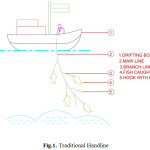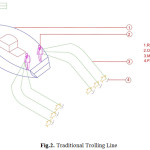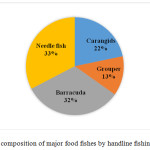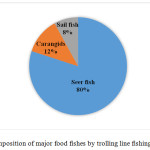Economic Analysis of the Hook and Line Fishery in Kombuthurai Coast, Tamil Nadu
Kalidoss Radhakrishnan1 * , Muthupandi Kalaiarasan2 , M.S. Madan1 , P.N. Ananth3 , T. Umamaheswari4 and R Velmuruga4
Corresponding author Email: theradhakrishnan@outlook.com
DOI: http://dx.doi.org/10.12944/CWE.11.3.28
The present investigation is about the economic analysis of the hook and line fishery along the coast of Kombuthurai, Thoothukudi district of Tamil Nadu. Inferences from the study indicated that that hook number 5, 6 and 7 were found ideal for commercial exploitation of Carangids, Grouper, Barracuda and Needlefish in angling by wielding fresh condition live bait. Using the artificial lure number 3.5, 4.0 and 4.5 applied in trolling line, the most dominant catch was seer fish (80%) and least in sailfish (8%). Significantly the study reports that the highest gross revenue ₹42060/trip was made in trolling line than that of the handline of ₹26400/trip ascribed by targeted of high market value species. The trolling line crew share per person was twice over than the handline fishing (₹3821/trip). Instead of unorthodox eye estimation of fish weight, a novel approach of weight based fish sale (for low to high market value species) was observed in Kombuthurai fishing village and this practiced also espoused by a neighbor fishing village.
Copy the following to cite this article:
Radhakrishnan K, Kalaiarasan M, Madan M. S, Ananth P. N, Umamaheswari T, Velmurugan R. Economic Analysis of the Hook and Line Fishery in Kombuthurai Coast, Tamil Nadu. Curr World Environ 2016;11(3). DOI:http://dx.doi.org/10.12944/CWE.11.3.28
Copy the following to cite this URL:
Radhakrishnan K, Kalaiarasan M, Madan M. S, Ananth P. N, Umamaheswari T, Velmurugan R. Economic Analysis of the Hook and Line Fishery in Kombuthurai Coast, Tamil Nadu. Curr World Environ 2016;11(3). Available from: http://www.cwejournal.org/?p=16536
Download article (pdf) Citation Manager Publish History
Select type of program for download
| Endnote EndNote format (Mac & Win) | |
| Reference Manager Ris format (Win only) | |
| Procite Ris format (Win only) | |
| Medlars Format | |
| RefWorks Format RefWorks format (Mac & Win) | |
| BibTex Format BibTex format (Mac & Win) |
Article Publishing History
| Received: | 2016-03-05 |
|---|---|
| Accepted: | 2016-11-29 |
Introduction
Marine fishers use different type of crafts (boats) and gears (nets) for harvesting fish and its efficiency is significantly important for better income. Hook and line is a traditional gear which habitually operating in the motorized and mechanized vessels due to nature of the gear such as simple for construction, easy to operate and selective in nature.4 In the recent years, the practices of hook and line are fascinating amid fishers; it excels in capturing high market value species namely the seer fish, mackerel, tuna, elasmobranchs etc.4,26,27 With worthiness, the hook and line were deemed as important, so studies on their performances were done for better understanding.5,20,11,27 The hook and lines contribute about 2 % of the total marine fish landing of India and the share of mechanized hook and lines are with 0.05 lakh tonnes and outboard hook and lines tunes to 0.59 lakhs tonnes.25 Among hook and line, the handline, pole and line, trolling line, jigging line and longline are prominent which is in practice throughout coastal region of India. It was recognized as eco-friendly fishing gear than other kinds of fishing practices but it also catches the non-target species.3,19,17,7 It is also interesting to note that they perform even in the rocky area and uneven bottom places as well.10
Bait is the key factor in line fishing, it dependents on the foraging behaviour of fish,12,10 stimulants, and sensory modalities.14,16 The taste, texture, and size of the feed also important factors which encourage the fish to approach the feed. The environmental parameters including light, temperature, current and prey density also affect the feeding behavior.16 Low market value fishes are mainly sardine, and squid however, they are also used for human consumption and considerably the price of baits price has also increased over a period of time. Hence, it is important to identify alternative bait which ought to be efficient, accessible, easy to operate with high catch efficiency, long life, and low cost. Research and Development initiatives have focused on developing artificial baits, and similar, however, a phosphorescent plastic bait was developed during 1960 –1970.22 A modern fish lure was developed by Heddon and Pflueger in Michigan during the early 1900s. Despite, a further development many studies were also carried out throughout the world in these aspects.13,15 It is observed it has become common in fishing using lure and fresh conditioned bait and is gaining importance especially in the study area viz., Thoothukudi coastal region of Tamilnadu due to higher catch efficiency and lower operating cost. The idea for this investigation is to understand the economic analysis of handline with live bait and trolling with artificial fish light lure practiced by the fishermen. As part of the economic analysis, the study also targeted to learn and document the gear description and operation details.
Materials and Methods
The present study was conducted at Kombuthurai landing centre (Lat. 8o34’50.49” N and Long. 78o08’12.91” E) during the period September 2014 to May 2015. For the present study an experimental fishing was conducted on handline (Fig. 1) and trolling line (Fig.2); this and their descriptions are presented in Table 1. The mainline and branch line are made of nylon monofilament. In the present study three different sizes of ‘J’ type hooks viz. hook no. 5,6 and 7 in hand line and three different sizes of artificial lures viz. 3.5, 4.0 and 4.5 in trolling lines were found to be used by the fishermen. A light was made avail to inside the lure to attract the fish and it lighting whenever it shakes. To elicit the economic analysis of hand and trolling lines the primary data was collected from all the handliners (20) and trolling lines (15) the Kombuthurai landing centre, Thoothukudi district, Tamil Nadu using a pre-tested interview schedule. Data pertaining to details of fishing gears especially the design and operation catch details, price and other relevant information were also collected for the study. The secondary data on gear operations and number of fishermen using different crafts and gears were collected from the State Fisheries Department of Tamil Nadu, Government of Tamil Nadu. For this study, the cost of production was grouped into two categories as fixed and operating costs and cost for deriving results on the economic analysis. Formulae used for the calculation were standard methods adopted for the study as indicated.
Net return = Gross revenue - Total cost
Gross revenue = price of fish / kg (₹) X quantity of fish caught on that day
Total cost = Total Fixed Cost (TFC) + Total Variable Cost (TVC)
TFC is the sum of fixed cost and TVC is the sum of the variable cost.
The results are presented in the tabular and graphical form. The entire data analysis was thru in Microsoft Office, 2016 in windows 8.0 version.
Table 1: General description of the Handline and Trolling line in Kombuthurai coast
|
Sl.no |
Name of the items |
Trolling line with artificial lure |
Handline with Natural bait |
|
|
Length of mainline (m) |
25 |
25-30 |
|
|
Height of branch line (m) |
No |
0.5 |
|
|
Height between the branch line (m) |
No |
0.5 |
|
|
Hook/Lure number |
3.5,4.0 and 4.5 |
5,6 and 7 |
|
|
Bait |
Artificial lure |
Live and natural bait |
|
|
Depth of operation (m) |
20 |
25-30 |
|
|
Material used for mainline |
Monofilament (Nylon) |
Monofilament (Nylon) |
|
|
Diameter of mainline (mm) |
1.5 |
1.3 |
|
|
Material used for branch line |
Monofilament (Nylon) |
Monofilament (Nylon) |
|
|
Diameter of branch line (mm) |
No |
1.1 |
Results and Discussion
Operational Details
The experimental handline and trolling line were operated by FRP boat 15 m overall length and each fitted with 9.9 hp Out Board Motor (OBM). The towing speed about 5 to 6 knots while fishing and running speed about 10 kw/hrs. The numbers of the crew for trolling and handline was found to be 3 and 4 persons / boat respectively. The handline was operated (Fig 1) during October to March of every year. But, a study stated that the handline was operated around the year and peak season during January to March.18 Handline of 3 to 20 m length and 1 to 20 hooks were used in in Nicobar.1 The float was attached for the easy identification of the line. The distance between each line was about 10 to 12 feet to cover a wide area and avoid the escape of fishes. The bait was varied with fishing methods as well as target of the species. In addition, the prawn, sardine, anchovies and squid was the prominent baits which employed in handline and trolling line.2 In another study in Nicobar, found that the fish (sardine, anchovies, and carangids), hermit crab and filamentous algae were used as live bait in handline, trolling line and longline.1,21 However, a better catch efficiency was recorded by using the fresh condition live bait rather than natural bait in dead condition in Kombuthurai. As similarly, the fresh condition baits were also utilized to capture the carnivore fishes in Nicobar.21
The trolling line with lure operated (Fig 2) during the southwest monsoon season which means from the month of May to September and jigging in June and July; which is in accordance with the earlier reports.18 The bright colour lure (red and black) was performed during water turbid periods and the dull colour lure during clear water periods. The low-cost lure (₹120) was utilized about 5 to 6 operation and the high-cost lure (₹500) 15 to 20 operation. However, for a single operation, 20 to 25 lure was employed. The double hook lure was performed for better catch efficiency and distance between the trolling line about 1.0 to 2.0 m. The branch line length was uneven due to avoid the fish catch from escapement. A locally made artificial baits were used in Nicobar using broiler chicken feather, plastic waste, rubber waste, nylon rope, nylon twine and fish lure.21
 |
|
 |
|
Table 2: Operational and techno-economic characteristics of the Handline and Trolling line in Kombuthurai coast
|
Sl.no |
Name of the items |
Trolling line with artificial lure |
Handline with Natural bait |
|
|
Type of fishing boat |
FRP |
FRP |
|
|
Length of the fishing boat (M) |
15 |
15 |
|
|
KW/ hrs. |
10 |
10 |
|
|
On board facilities |
No |
No |
|
|
Fuel (litre/trip) |
75-85 |
120-130 |
|
|
Number of the crew |
3 |
4 |
|
|
Number of shares |
5 |
6 |
|
|
Gear expenses (₹) |
650/piece |
3000/roll |
|
|
Other running cost (₹) |
150 |
150 |
|
|
Ownership |
Single |
Single |
|
|
Fishing days (days per annum) |
52 – 60 |
113 – 120 |
|
|
Horse Power of the engine (hp) |
9.9 |
9.9 |
Species Composition
The computed catch rate of the handline and trolling line is presented in table 3 and 4 respectively. The larger size grouper landing was accounted in hook no. 5 and the minimum in 7 in handline, as well as the larger size of seer fish catch, was recorded in lure size no. 4.5 and least in 3.5 in trolling line. Needlefish was the most dominant group of finfish (33%) in the handline fishery and least dominant catch was groupers (8%) (Fig 3). But, in a trolling line the dominant group of finfish like seer fish (80%) followed by carangids (12%) and sailfish (8%) was observed (Fig 4). Threadfin was the prominent landing species in handline at Thoothukudi about 36% followed by 20% of lethrinids, 19% of Belone spp., 10% of serranids, and 6% of carangids23.An attempt was taken to study the species composition in trolling line operation of which mackerel, queenfish, Caranx sp. (carangids), herring, cobia, and tuna was the major fish catches6. The mackerel was highest than followed by queen fish and caranx. The average catch per day ranged from 21.2 and 116.5 kg. The seerfish, tuna, barracuda, caranx and mackerel landing was occurred in trolling line by using the artificial and natural bait1.
 |
|
 |
|
Economics
It is a fact that the technical features of the fishing vessels influence the fish catch8,9 this study also attempted in these lines. This obtained by better utilization and optimum substitution of the input variables.
The gross income for handline (Table 3) and trolling line (Table 4) were calculated and a sum of ₹26400 and ₹42060 was earned respectively which also depends on the quantity of landing and price of the fish. It was observed that 222 kg of fish landings occurred through handline and 96 kg in trolling line. The species selectivity also affects the fishing strategies and distribution (horizontal and vertical) of fish. The area and depth of operation based on the skipper experiences and fish detecting devices. The catch rate improved with increased depth of operation. However, the price per kg realized was found to be higher for seer fish than those of others species; a similar kind of report was inferred in another study.24 The price changes also occurred due to change in supply and price of the related landing species. The price of fish is highly elastic compared to agriculture commodities due of nature of perishability and uncertainty in landings. The market timing is another factor which affects the price.24 Techno-economic and operational characteristics of fishing vessels are presented in Table 2
Table 3: Gross Income of the handline
|
Sl.no |
Name of fish |
Total fish weight (kg) |
Price (₹) / kg |
Gross Income (₹) |
|
1. |
Carangids |
150 |
130 |
19500 |
|
2. |
Grouper |
12 |
150 |
1800 |
|
3. |
Barracuda |
30 |
70 |
2100 |
|
4. |
Needlefish |
30 |
100 |
3000 |
|
Total |
26400 |
Table 4: Gross Income of the trolling line
|
Sl.no |
Name of fish |
Total fish weight (kg) |
Price (₹) / kg |
Gross Income (₹) |
|
1. |
Seer fish |
80 |
500 |
40000 |
|
2. |
Carangids |
15 |
130 |
1950 |
|
3. |
Sailfish |
1 |
110 |
110 |
|
4. |
Total Income |
42060 |
||
Table 5: Cost and returns of hand line and trolling fishing (₹per/trip)
|
Sl.No |
Name of particulars |
Hand line fishing |
Trolling fishing |
|
1.
|
Total variable cost Fuel Ice Food Other operating cost Total |
3125 50 150 150 3475 |
2000 50 0 150 2200 |
|
2. |
Gross revenue |
26400 |
42060 |
|
3. |
Net return (without fixed cost) |
22925 |
39860 |
|
4. |
Number of shares |
6 |
5 |
|
5. |
Share per crew |
3821 |
7972 |
|
6. |
Owners share |
7642 |
15944 |
The capital cost of the handline operated vessel accounts to ₹160850 and for trolling line ₹158000 which consists of craft cost at ₹155000 and for the lines about ₹3000 and ₹5850 respectively. In fixed cost, the cost of repairs and maintenance of the fishing vessels about ₹15000/yr for handline and ₹2000/yr. for the trolling line. The cost and returns for this study were calculated using the collected data (Table 5). The economic returns were found to be higher in trolling with a return of ₹39860 than that of the handline fishing ₹22925 excluding the fixed cost and the crew share was about ₹7972 and ₹3821 respectively. In addition, the owners have two shares for the craft and engine. The owner share (earning) was twofold higher in trolling line than the handline fishery which means the trolling line vessel owner earned an income of ₹15944 and the handline vessel owner income with ₹7642.
Market structure
In India, the domestic fish marketing system is carried out by the private dealers between producer and consumer.8 An auctioneer is a middle man in marine fish marketing and catches provided by fishermen and who auctions the fishes to various stakeholders. The auctioneer offers advance money to fishermen to take the rights to the auction of his catches, and also charged 5 % of the total sales. The fish sale practices by open auction for a bundle of fish in marine fish landing centre in India24,26 and there is no exception for Tamil Nadu. But controversial to this practice, fish sales have been practiced by the open auction for price per kg weight. This practice was initiated and practiced in the study area and this also accepted by a nearby village Amalinager as they believe that by adopting this method underestimation of fish price can be curtailed. This paves an easy way to estimate production at the individual level to draw policy conclusions and to initiate development interventions.
Conclusion
In the present study, an attempt has been made to evaluate the income of the handline and trolling line fishery, Kombuthurai, Tamil Nadu. The trolling line fishermen had higher gross income (₹42060/trip) as compared to handline fishers (₹26400/trip). This greater income was achieved by target fishing and high market value species. A novel marketing practice was initiated and practiced by them, which is open auction price per kg weight method. In marketing, is considered as an efficient method, so, upcoming studies should focus this. By practicing line fishery, help us to compute the stock status, potential catch, bycatch reduction. So, upcoming policies should give importance to the hook and line fishery to secure the juveniles and sustainable fisheries.
Acknowledgement
The author would like to thank the Research Centre of Central Marine Fisheries Research Institute, Thoothukudi for providing facilities for undertaking this study. Authors also thankful to Mr. Muthukumar for his artwork.
References
- Ahmed, S.Z., Ravikumar, T., Krishnan, P. and Jeyakumar, S. Traditional fishing crafts and gears used by the Nicobari tribes in Car Nicobar. Indian Journal of Traditional Knowledge, 12(1): 144-148 (2013).
- Balasubramanyan, R. On the use of different natural baits for sea-fishing in India. Fishery technology, 1(1): 41- 47 (1964).
- Belda, E.J. and Sanchez, A. Seabird mortality on longline fisheries in the western Mediterranean: factors affecting bycatch and proposed mitigating measures. Biological Conservation, 98(3): 357-363 (2001)
CrossRef - Bjarnason, B. A. Handlining and squid jigging. Food and Agriculture Organization of the United Nations Rome, (1992)
- Bjordal, Å. Effect of different long-line baits (mackerel, squid) on catch rates and selectivity for tusk and ling. ICES.(1983)
- Dhawan, R.M., Namboothiri, P.V.S. and Gopinathan, V.G. Results of trolling line operations in Goa waters during 1965-68. Indian Journal of Fisheries, 16 (1&2): 181-187 (1969)
- Diaz, G.A. The effect of circle hooks and straight (J) hooks on the catch rates and numbers of white marlin and blue marlin released alive by the US pelagic longline fleet in the Gulf of Mexico. North American Journal of Fisheries Management, 28(2): 500-506. 2008
CrossRef - FAO. Techno-economic performance of marine capture fisheries. Fisheries technical paper No. 421. Food and Agriculture Organization of the United Nations Rome. (2001)
- FAO. Economic performance and fishing efficiency of marine capture fisheries. Fisheries technical paper No. 482. Food and Agriculture Organization of the United Nations Rome (2005)
- Hameed and Boopendranath, 2000 Modern fishing gear technology. Daya Publishing house, Delhi, 186 p.
- Lewison, R.L., Freeman, S.A. and Crowder, L.B. Quantifying the effects of fisheries on threatened species: the impact of pelagic longlines on loggerhead and leatherback sea turtles. Ecology letters, 7(3): 221-231 (2004)
CrossRef - Løkkeborg, S. Longline bait: Fish behaviour and the influence of attractant release rate and bait appearance. Dr. scient. thesis. Department of Fisheries Biology University of Bergen. Bergen, 1989, 9-27 (1989)
- Løkkeborg, S. Reduced catch of under-sized cod (Gadusmorhua) in Longlining by using artificial bait. Canadian Journal of Fisheries and Aquatic Sciences 47: 112-1115 (1990).
CrossRef - Løkkeborg, S., and Bjordal, Å. Species and size selectivity in longline fishing: a review. Fisheries Research, 13(3): 311-322 (1992)
CrosRef - Løkkeborg, S. andJohannessen, T. The importance of chemical stimuli in bait fishing—fishing trials with presoaked bait. Fisheries research, 14(1): 21-29 (1992).
CrossRef - Løkkeborg, S., Siikavuopio, S.I., Humborstad, O.B., Utne-Palm, A.C. and Ferter, K. Towards more efficient longline fisheries: fish feeding behaviour, bait characteristics and development of alternative baits. Reviews in Fish Biology and Fisheries, 24(4): 985-1003 (2014).
CrossRef - Kumar, K.A., Khanolkar, P.S., Pravin, P., Madhu, V.R. and Meenakumari, B. Effect of hook design on longline catches in Lakshadweep Sea, India. Indian Journal of Fisheries, 60(1): 21-27 (2013).
- Mathew, G. and Venugopal, K.M. Hooks and line fishery for 'Kalava' at Cochin. Indian Journal of Fisheries, 37(4): 347-355 (1990).
- Polovina, J.J., Howell, E., Parker, D.M. and Balazs, G.H. Dive-depth distribution of loggerhead (Carrettacarretta) and olive ridley (Lepidochelysolivacea) sea turtles in the Central North Pacific: Might deep longline sets catch fewer turtles? Fishery Bulletin, 101(1): 189-193 (2003)
- Ralston, S. Influence of hook size in the Hawaiian deep-sea handline fishery. Canadian journal of fisheries and aquatic sciences39: 1297-1302 (1982).
CrossRef - Ravikumar, T., Ram, N., Krishnan, P., Sankar, R.K., Sachithanandam, V. and Roy, S.D., 2016. Subsistence fishing methods of Nicobari tribes using traditional knowledge. Journal of Marine and Island Cultures, 5(1): 79-87.
CrossRef - Salómonsdóttir, E. Gervibeita, heimildaleit (Artificial bait, Literature research). The Icelandic Fisheries Laboratories, Reykjavík, Iceland. 1970.
- Sam Bennet, P. and Arumugam, G. Advancement in traditional fishing methods for nearshore fisheries around Tuticorin, Gulf of Mannar. Journal of the Marine Biological Association of India, 35(1&2): 105-108. 1993.
- Sathiadhas, R. and Narayanakumar, R. Price policy and fish marketing system in India. Journal of Biology Education, 11(4): 225-241 (1994)
- Sathianandan, T.V. Status of Marine Fisheries Resources in India – An Overview. In: ICAR funded Short Course on “ICT -oriented Strategic Extension for Responsible Fisheries Management, 05-25 November, 2013, Kochi.
- Sreekrishna, Y and Shenoy, L. Fishing Gear and Craft Technology. Directorate of Information and Publications of Agriculture, Indian Council of Agricultural Research, (2001)
- Vipin, P.M., Ravi, R., Pravin, P., Thomas, S.N. and Edwin, L. Longline fishing for high value species off Southern India with special reference to structural and operational changes.Fishery Technology 51: 87 – 92 (2014).







